This project explains how to install a Ground Fault Circuit Interrupt (GFCI) circuit breaker, branch circuit and electrical outlet under a kitchen sink for an instant hot water dispenser.
The new Ground Fault Circuit Breaker (GFCB) branch circuit under the kitchen sink will be installed per this wiring diagram:
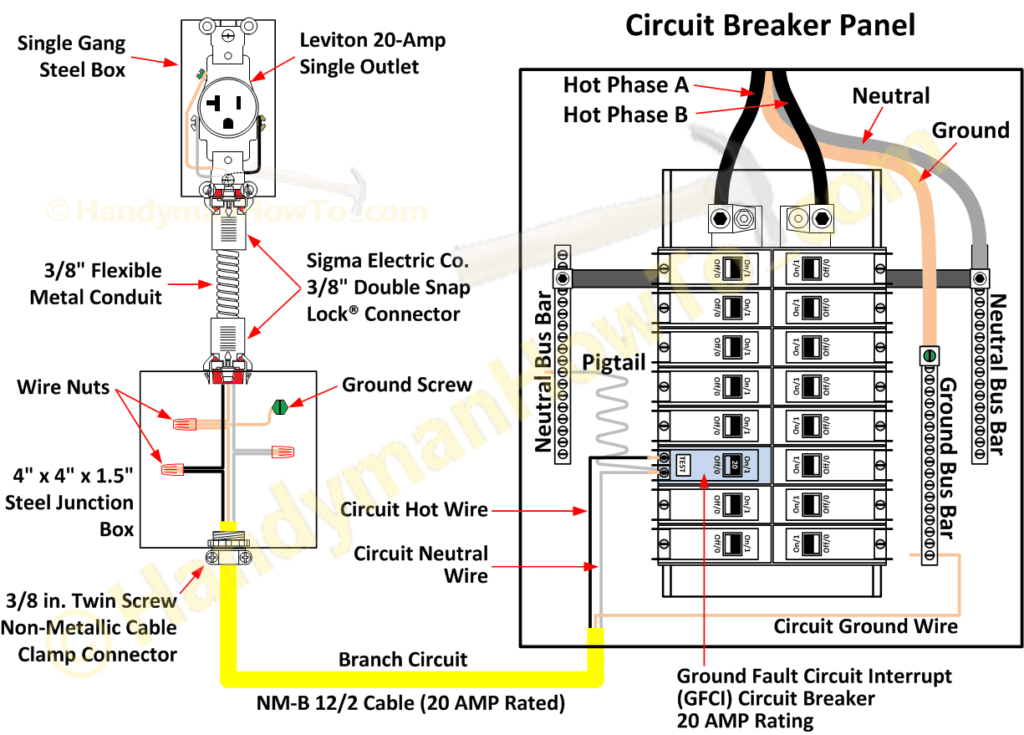
Compare the above wiring diagram to the new junction box and single electrical outlet installed under the kitchen sink:
Electrical Service Building Permit
Instant Hot Water Dispenser manufacturers may recommend the dispenser is served by a dedicated branch circuit. A new circuit and outlet may be also be required to handle the electrical load. An Electrical Service Permit (“Building Permit”), Inspection and Sign-off by your local Building Dept. is required for safety and compliance with Electrical Codes if installing a new branch circuit. Local Building Codes may also require GFCI protection, so check with your local Building Department or a licensed electrician for requirements in your area.
Applying for an Electrical Service Permit was a simple and I did it online through the Building Department’s website. As as homeowner, I’m allowed to act as my own contractor. No drawings were required and I stated in the DESCRIPTION OF WORK:
“Install a new branch circuit (NM-B 12/2 cable), 20 AMP ground fault circuit breaker and single electrical receptacle (20 AMP rated) under the kitchen sink for an instant hot water dispenser.”
I received an e-mail later the same day stating my application was reviewed by the Building Dept. and the permit fee was ready for payment by clicking on the link included with the e-mail. I paid the $50 permit fee online and the permit card was displayed in the web browser as an Adobe .pdf document ready for printing. I printed a copy and saved the permit document to my computer. Very nice! Sure beats taking time off from work to visit the Building Dept. office in person!
Hot Water Dispenser and Garbage Disposal on the Same Circuit?
A dedicated circuit and single outlet for the garbage disposal was already present under the kitchen sink. Could I have converted the outlet to a duplex split receptacle and used the same branch circuit for the hot water dispenser? Maybe.
It might be possible to install the hot water dispenser on the same circuit as the garbage disposal subject to the following considerations:
1) Manufacturer installation instructions: My Waste King Quick & Hot Elite Series hot water dispenser installation guide calls out the following electrical requirements:
- “120 volt, 60 Hz, AC only 15 or 20 ampere fused, grounded electrical supply is required.“
- “It is recommended that a separate circuit serving only your hot water dispenser be provided.”
2) Local Building Codes: Verify if local Building Codes allow a hot water dispenser to be on the same branch circuit with a garbage disposal.
3) Circuit Capacity: Confirm the power capacity of the garbage disposal branch circuit by doing the following:
- Locate the circuit breaker for the garbage disposal in the circuit breaker panel. The circuit breaker will have a 15 or 20 printed on the switch, which the rating in amperes (AMPs).
- Shutoff the circuit breaker and check if any other outlets, lights, dishwasher or appliances in the kitchen lose power.
If other appliances or outlets lose power when the circuit breaker if turned off, you should install a new dedicated circuit and breaker for the hot water dispenser. Should kitchen counter outlets or lights lose power, then you have improper electrical wiring and should consult with a licensed electrician to have the wiring problem corrected.
4) Electrical Load Calculation: Can the circuit support both appliances?
- Add the power required in AMPs for the hot water dispenser and garbage disposal together. Is this figure greater than the circuit breaker AMP rating? If greater, the circuit does not have sufficient capacity and it’s necessary to install a dedicated circuit and circuit breaker for the hot water dispenser.
- If the power in AMPs required for the two appliances is less than the circuit breaker rating by a “reasonable margin” – a good rule is to load a circuit to no more than 80% of capacity – then the two appliances may be served by a the same circuit if a split receptacle is used to separate the ON/OFF switch-controlled garbage disposal from the always-ON hot water dispenser.
GFCI protection isn’t required for a garbage disposal circuit, whereas local Building Codes may require GFCI protection for a hot water dispenser. A Ground Fault Circuit Breaker (GFCB) is easy to install with the right know-how and I prefer the peace of mind knowing only the water will be “hot” and not my body, especially after seeing the old, leaking and rusty hot water dispenser that I’m replacing (see photos below).
That’s a lot of conditions! Consult with a licensed electrician if in doubt.
Kitchen Sink Outlet: Circuit Load Calculation
My kitchen sink has a Waste King L-8000 garbage disposal that is plugged into a single electrical outlet controlled by a switch above the kitchen counter. The outlet is on a dedicated branch circuit having a 15 AMP circuit breaker with NM-B 14/2 cable. Note: NM-B 14/2 cable is rated for a maximum of 15 AMPs.
The 1 HP Waste King L-8000 garbage disposal pulls 7 AMPs.
The Waste King Quick & Hot Elite Series Hot Water Dispenser that I’ll be installing pulls 10.8 AMPS.
7 AMPs + 10.8 AMPs = 17.8 AMPs, which exceeds the 15 AMP garbage disposal branch circuit capacity by nearly 20%. A new branch circuit and circuit breaker is necessary for the instant hot water dispenser.
Leaky Instant Hot Water Dispenser
The following photo is the old hot water dispenser that was present when I bought the house. The installation was botched and I tend to believe the former homeowner did it himself as I can’t believe a professional plumber or electrician would do such poor quality work.
Here’s what’s wrong with this installation:
- Water dispenser electrical cord is poked through a hole in the cabinet and subfloor to an inaccessible GFCI outlet attached to the floor joists above the ceiling of the finished basement. The inaccessible electrical outlet is an electrical code violation.
- A bad practice is the electric cord slopes downhill, perfect for channeling water leaks to the electrical outlet. Cords should be arranged so there’s a drip loop (U-bend) so water doesn’t flow into the outlet.
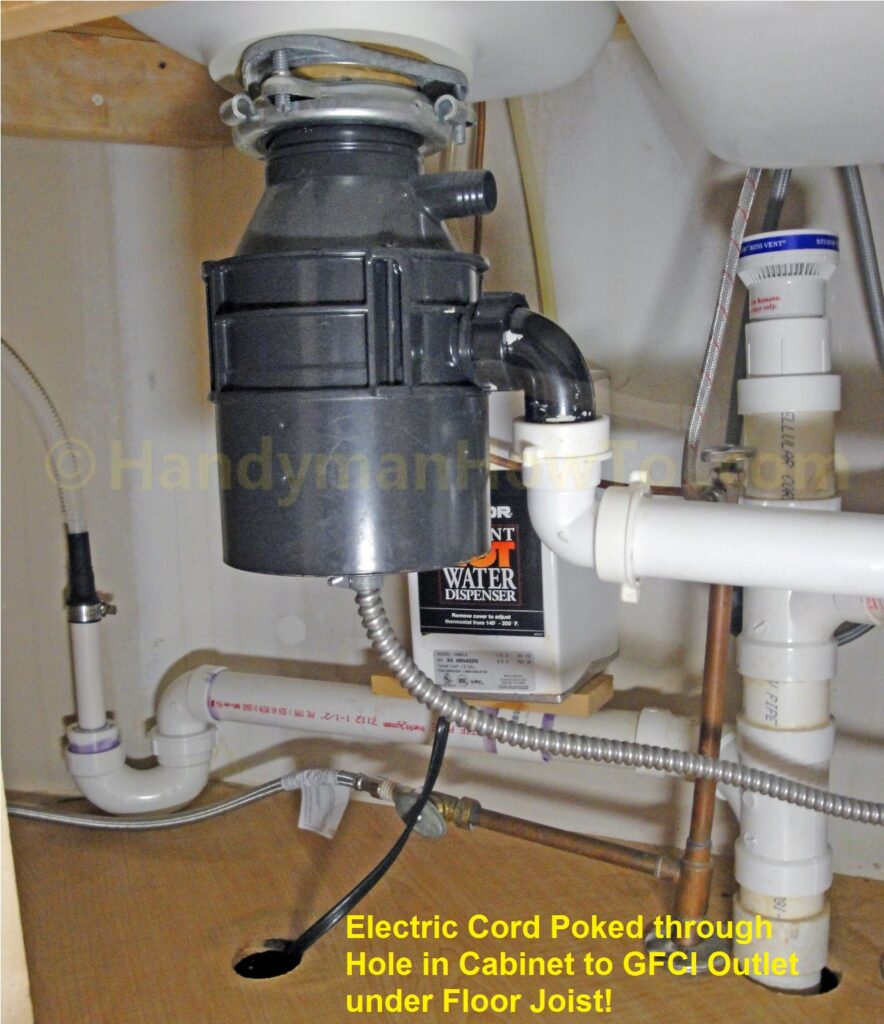
In the next photo, the hot water dispenser is sitting on a board supported by the dishwasher drain pipe. The only thing keeping the dispenser from tipping over are the faucet hookup tubes! The dispenser should be attached to the wall by a bracket.
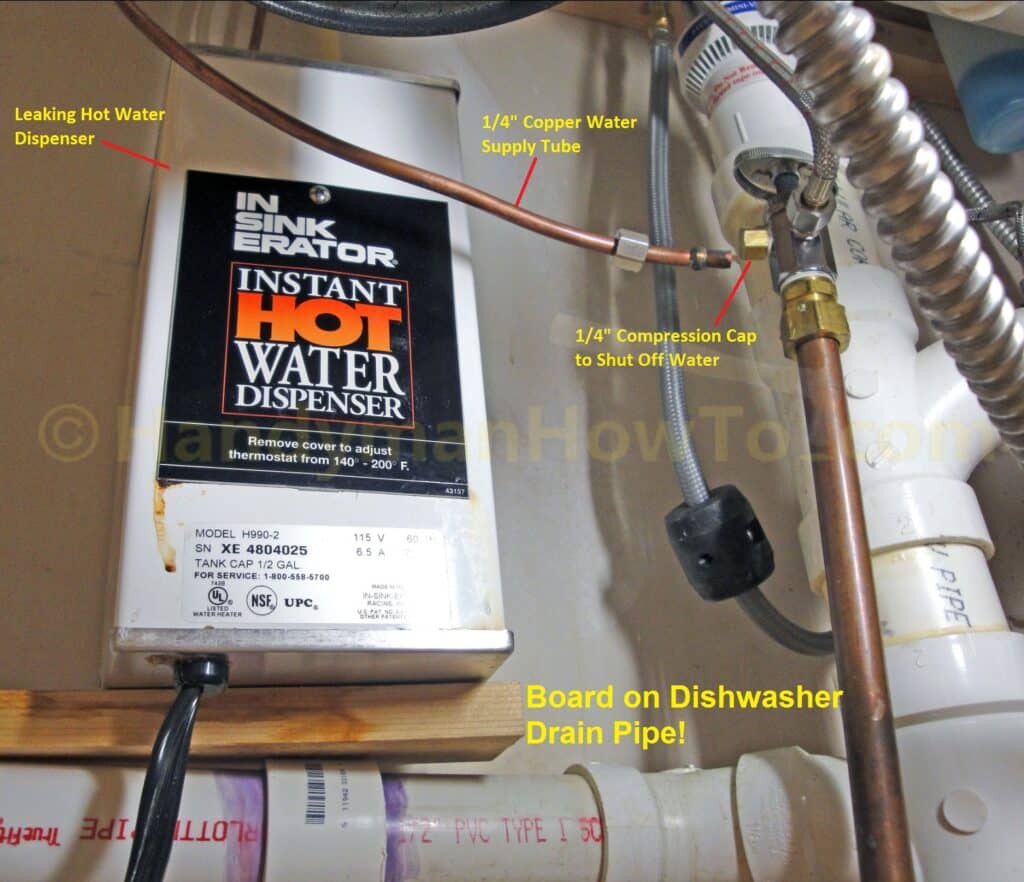
Lastly, the prior homeowner connected the instant hot water dispenser to the house hot water supply line – stupid and wasteful. Hot water dispensers should be connected to the cold water supply line.
Note that I’ve disconnected the 1/4″ water supply tube and capped off the supply valve in the above photo.
How to Wire an Electrical Outlet Under the Kitchen Sink
Electrical Safety
This project is should not be attempted unless you are very knowledgeable and careful about electricity, home wiring practices and the National Electrical Code. You can easily get yourself electrocuted, burned, maimed, killed, create a safety hazard and/or burn down the house. Hire a licensed electrician if in doubt.
Disconnect the Old Electrical Outlet and Branch Circuit
The GFCI receptacle under the floor joists for the old hot water dispenser will be removed with the NM-B 14/2 cable and circuit breaker in preparation for installing an entirely new 20 AMP branch circuit.
The dedicated circuit breaker for the old hot water dispenser is located in the circuit breaker panel in the basement:
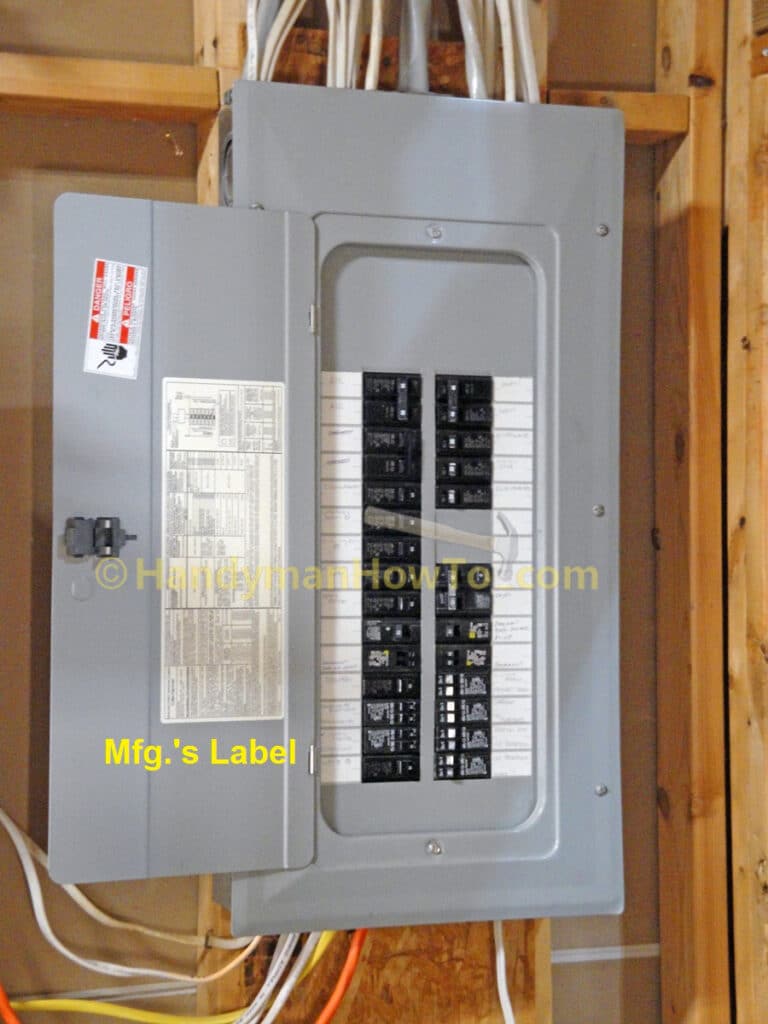
I removed the six screws from the panel cover to inspect the wiring and circuit breaker:
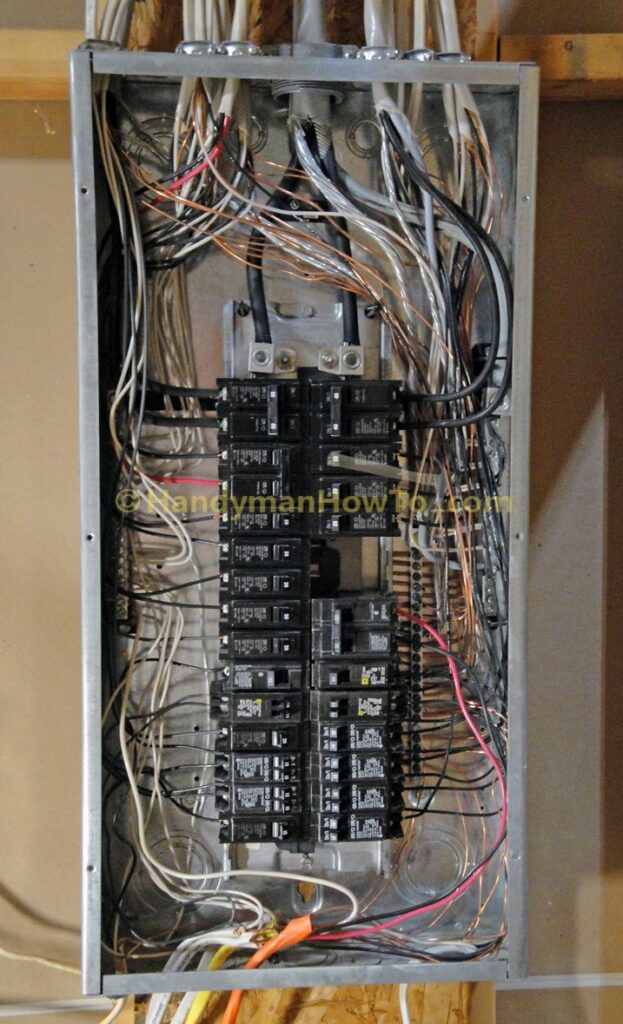
Couple of observations:
- My panel does not have a 150 AMP service disconnect main breaker. Instead, the service disconnect it outside on the electric meter box. This is OK, but having a service disconnect on the main panel is a nice convenience.
- There are 8 tandem circuit breakers serving 16 branch circuits.
This suggests a sub-panel should be installed because the main panel is out of space. - My home was built in 2002, before Arc Fault Circuit Interrupts (AFCI) circuit breakers were required in the 2008 National Electrical Code (NEC).
AFCI circuit breakers are not available in duplex models, so a sub-panel to install AFCI breakers for the bedrooms, bathroom, kitchen, etc. will be needed. I’ll hire an electrician to do this as the work will be significant.
Ah, yes – my old friend the original homeowner has done some jackleg work here with the finished basement wiring.
- Some history: The basement was finished and wired without obtaining a Building Permit and proper inspections by the former homeowner to avoid a property tax increase. I learned this when I filed a permit for finishing the basement bathroom and the Building Inspector said the finished basement was not in their records; I received a reasonable increase in my property tax assessment.
- Before I bought the house, the Home Inspector noted the basement wall outlets were not grounded – it was corrected by connecting the ground wire in a junction box.
- A new finding as I’ll point out in later photos, are several of the cables entering the bottom of the panel are not secured by cable clamps.
- I see upon closer inspection there are a couple of Siemens and Square-D circuit breakers in the panel instead of approved Eaton / Cutler-Hammer Type BR breakers. To my knowledge, Siemens and Square-D breakers are not explicitly approved for the Cutler-Hammer Type BR Load Center and will be changed out when I have a sub-panel and AFCI breakers installed.
At this time, the panel is energized and it’s extremely important to keep hands and tools away from the wiring to avoid shock/electrocution!
Closeup the of the 15 AMP circuit breaker serving the old hot water dispenser electrical outlet. I’ve flipped the switch to the Off position.
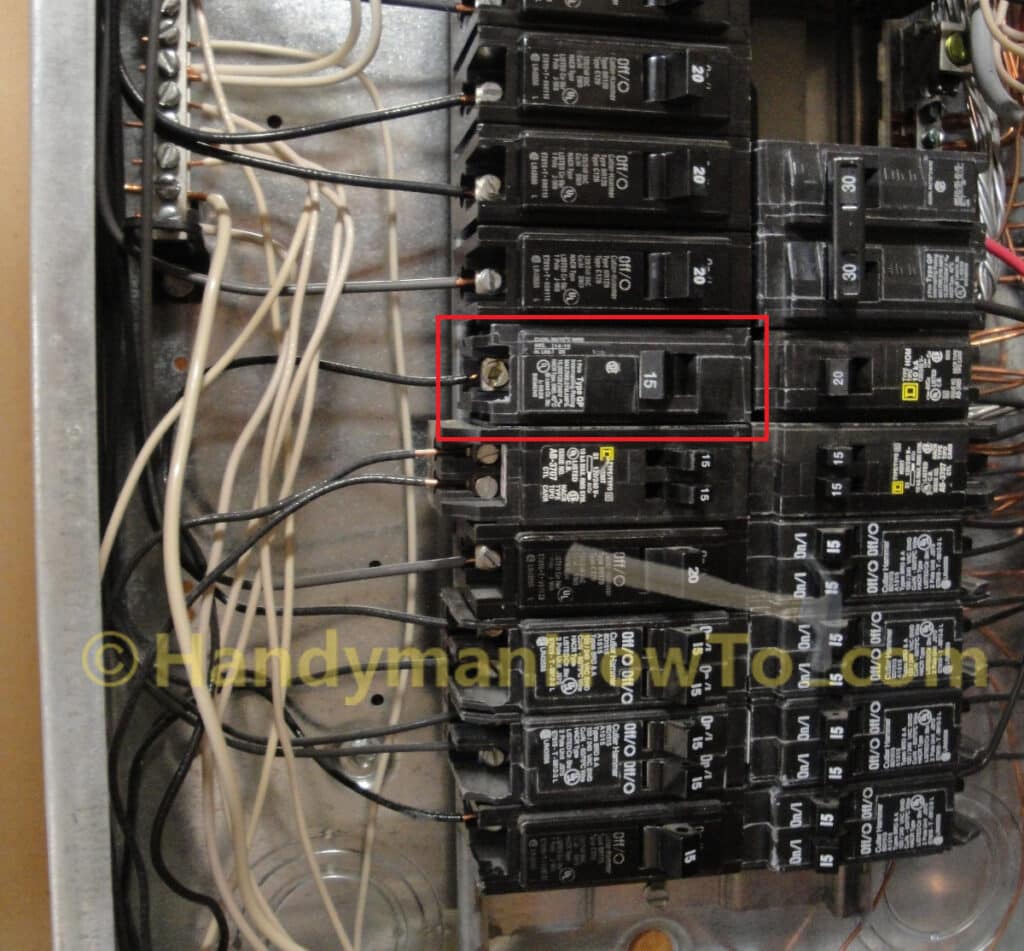
Trace the Old Branch Circuit Wiring
I needed to trace the NM-B 14/2 cable run to the GFCI outlet mounted on the floor joist. Since the electric cable and GFCI outlet are out of reach in the space between the drywall ceiling of the finished basement and ground level floor joists, I duct taped my non-contact voltage detector to a walking stick to probe the cable and outlet from a distance.
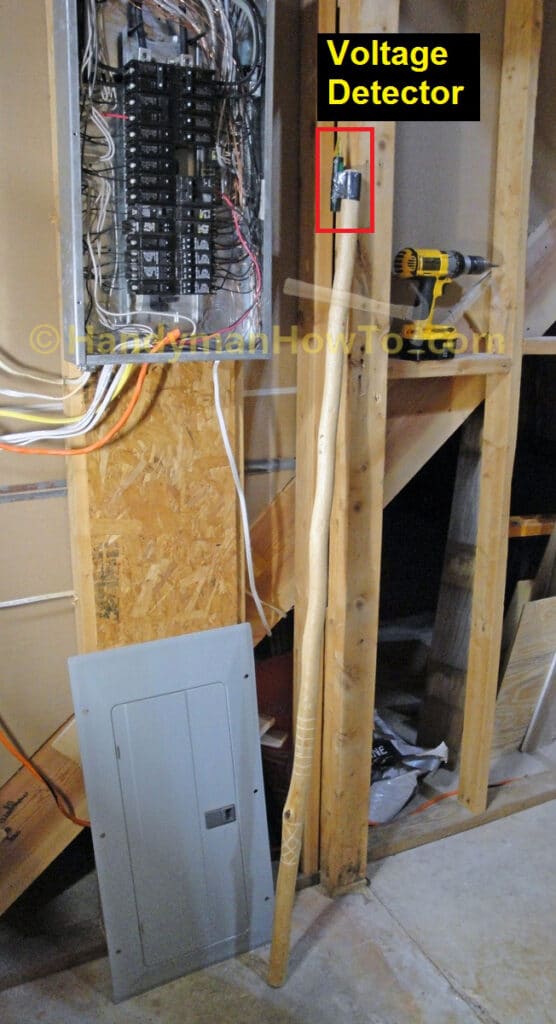
I setup a 24 foot extension ladder in the next room of the unfinished side of the basement to look between the floor joists bays to find where the old GFCI outlet is mounted. The house sits on a hillside with a deep basement.

From the top of the ladder, I can see the GFCI receptacle, white NM-B 14/2 cable and hole in the subfloor where the cord from the old hot water dispenser was poked down to plug into the outlet. Installing a GFCI outlet like this was a bad idea and the outlet should have been moved when the basement was finished. The hot and cold water copper pipes and PVC drain pipe are also seen.
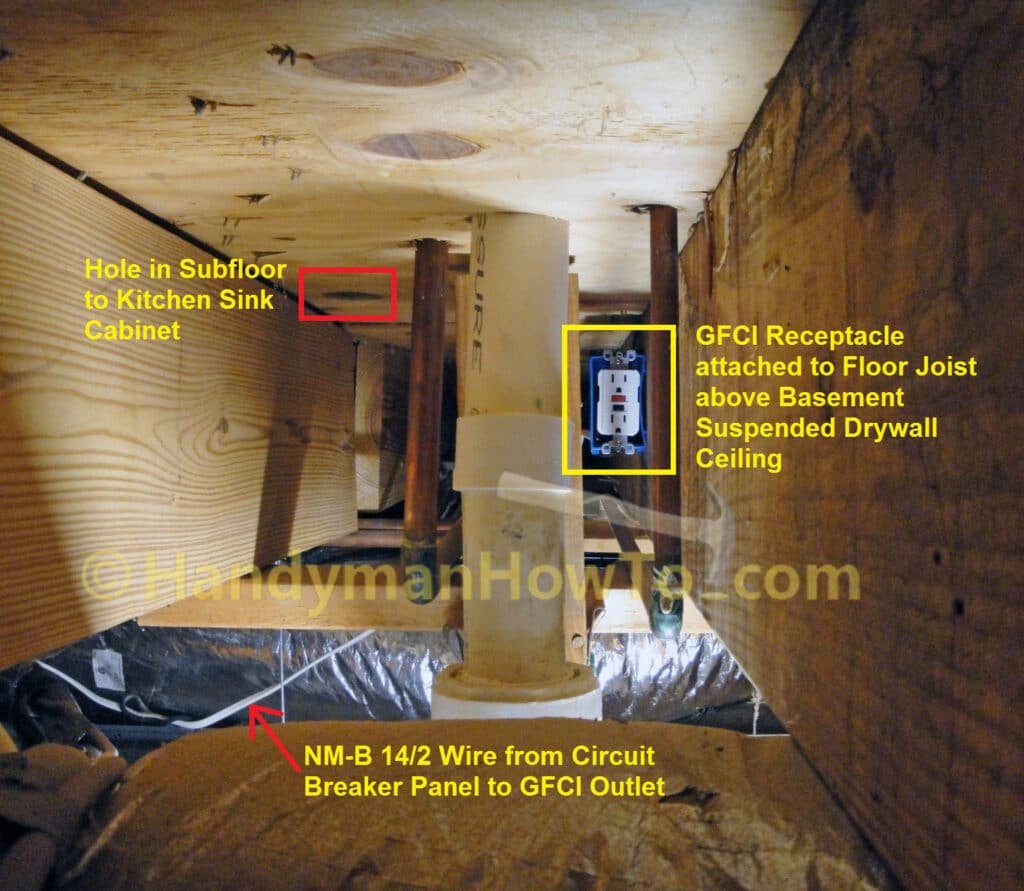
The non-contact voltage detector beeps loudly and flashes when it senses voltage. Using the stick, I was able to place the voltage detector probe against the GFCI outlet and NM-B 14/2 cable to verify the circuit was hot when the circuit breaker was On and no voltage was present the circuit breaker was Off. I needed to be certain I had located the correct electric cable and circuit breaker because parts HVAC flex duct blocked my view of the cable.
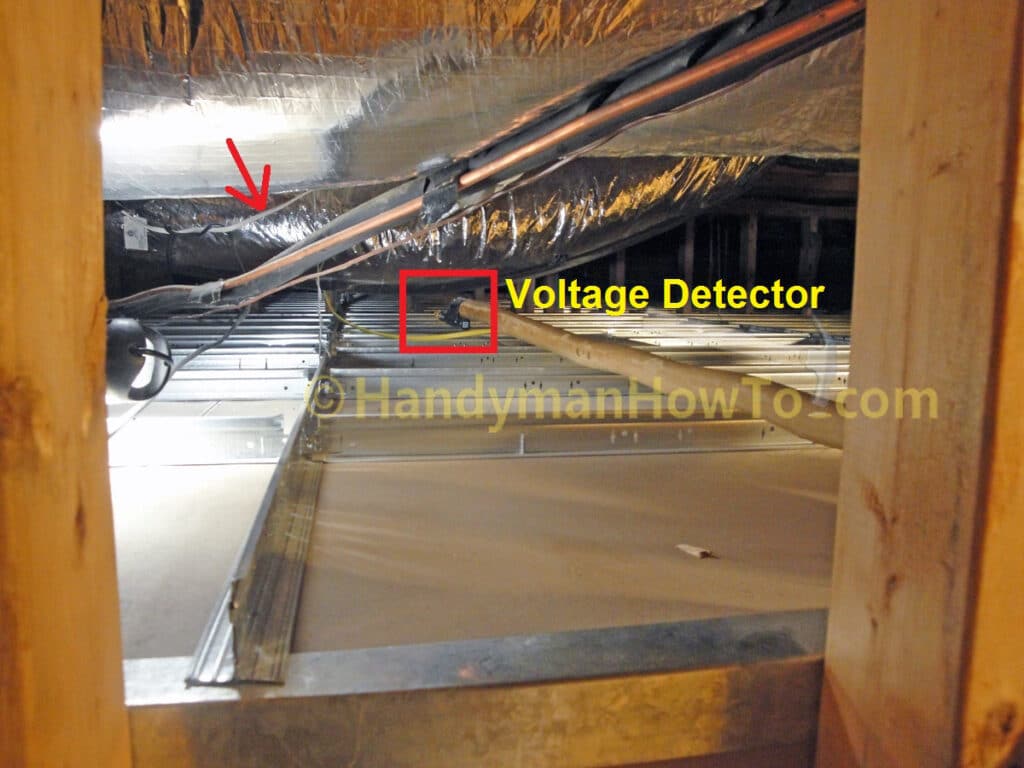
This project is continued in How to Wire an Electrical Outlet Under the Kitchen Sink – Part 2.
Stay safe,
Bob Jackson